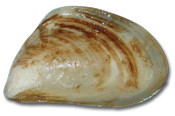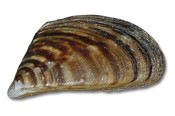Place of origin
Quagga and zebra mussels originate from the Caspian and Black Sea regions in Eastern Europe. In 1986, zebra mussels were first discovered in Lake St. Clair (the Great Lakes). In 1989, quagga mussels were first discovered near Lake Erie. They were introduced through the discharge of ballast water from ships.
Since then, invasive mussels have spread throughout the Great Lakes and many lakes in Ontario, Manitoba and the United States. Overland watercraft transport has been the main pathway of spread across Canada and the United States.
To our knowledge, zebra or quagga mussels are currently not established in Alberta. For a map of confirmed locations, visit:
Identifying quagga and zebra mussels
Quagga and zebra mussels, which pose a significant threat to Alberta's aquatic ecosystems and economy, can be identified through key characteristics.
Quagga mussel (Dreissena rostriformis bugensis)

- 1 to 5 cm, D-shaped shell
- Brown and yellow-white in colour, may have faint banding pattern
- Native to Ukraine, now found in various parts of North America, such as in the Colorado River system – a popular destination for Alberta snowbirds
- Live up to 5 years
- More adaptable than zebra mussels – can attach to softer substrates and survive in colder water.
Zebra mussel (Dreissena polymorpha)

- 1 to 3 cm, triangular-shaped shell
- Brown and yellow-white in colour, usually with light-dark banding or zigzag pattern
- Native to Russia, now found in various parts of North America, such as in Lake Winnipeg and elsewhere in Manitoba.
Invasive Species Hotline
Do you think you've spotted a quagga or zebra mussel? Remember, an attached mussel is an invasive mussel, native mussels will be buried in the sand.
Report it to Alberta's Invasive Species Hotline at 1-855-336-BOAT (2628).
Similar species
Use keyboard or mouse to scroll through the gallery
Video: Impacts of Zebra Mussels
Take action
Clean, drain and dry your gear
If you are transferring a watercraft or equipment used in water (that is, hip waders, life jackets, kayaks, construction equipment, etcetera) between waterbodies, make sure to practice clean, drain and dry efforts between uses.
Visit the pages below to find information boaters need to follow to help stop the spread of AIS:
Get the facts on how to clean, drain and dry your type of boat:
- Boating
- Clean, drain, dry your gear
- Quick facts: aquatic invasive species
Includes information for motorized watercraft. - Quick facts: aquatic invasive species [non-motorized watercraft]
Don’t Let It Loose
Moss balls, also known as marimo balls, are popular aquarium plants that have been found in the past to be contaminated with invasive mussels. Avoid introducing invasive species by never releasing aquarium contents, live bait, live food, or other organisms into waterbodies.
Zebra and quagga mussels are prohibited species in Alberta under the federal Fisheries Act and Fisheries (Alberta) Act. Never import, own, sell or transport these species in Alberta. For more information, visit:
Invasive mussel decontamination protocol for retailers

